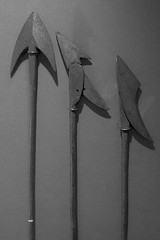(15th in the search for the ideal edition for an MDM)
Since I have undertaken to manhandle this Leviathan, it behooves me to approve myself omnisciently exhaustive in the enterprise; not overlooking the minutest seminal germs in his blood, and spinning him out to the uttermost coil of his bowels.
— Chapter CIV, "The Fossil Whale"
Now that we're
homeward bound to the next MDM, and having examined the currently available haul of
Moby-Dick editions, we can conclude our search for that
one edition that is best suited to be your companion for the marathon's long voyage from "Call me ..." to "... another orphan."
 |
| I wear the chain I forged in February. |
Faithful readers will recall the
launch of this quest back in February, when I conflated my post-holiday zeal to conform to the dietary guidelines of the Department of Health & Human Services, with a practical need of all conscientious marathoners. Although the adult beverages ebbed and flowed (two-a-day is a devilishly meager ration!), the literary hunt was pleasantly self-motivating. I'm sure that many of us Melvillians are like William Pettit of
The Moby-Dick Collection, and the omnivorous
Stevereads—we're
bibliomaniacs. We find books to be fascinating
objects.
This hunt was also an excuse to explore some fine, old municipal libraries. It turned out to be a learning experience as well. I had unconsciously assumed, along with many marathoners, no doubt, that after being in circulation for over a century and a half, and for much of that time being a "Very Important Book," all editions presented the
same text.
In the innocence of my heart! It took me a month to
realize that not until 1988 (thanks to the labors of Hayford, Parker, and Tanselle) was a researched, corrected,
standard text published. Not to say that the
process of revision has ceased, but at present, the Northwestern-Newberry
Moby-Dick is generally accepted as accurate by folks whose business it is to know.

So were our
criteria refined.
Back in March I fantasized that an ideal marathon tome might be fashioned from the
Library of America hardcover 3-pack of
Redburn,
White-Jacket, and
Moby-Dick (Northwestern-Newberry compliant, of course) by excising the two unnecessary (for the marathon) works, and re-binding the remainder. Soon after, I discovered that Library of America had done just that!
This, for me, is
the one.
The Library of America "Paperback Classics" edition (ISBN: 978-1-59853-085-8) was released about a year ago. It can be found new at Amazon for less than $10. As with all of the LOA Melville titles, it presents the Northwestern-Newberry text. At 696 pages,
extranea are not excessive—a 17-page
Introduction by Professor Edward Said of Columbia University, a 5-page
Chronology, and 16 pages of
Notes; no illustrations. It appears to be an exact clone of the hardcover edition (the text may be a split-hair larger, measured with calipers), but on different paper stock.
It's cut to nearly the same page size as the hardcover, measuring 5.125" x 8" x 1.25". It weighs in as the
lightest of the N-N compliant editions examined: 22.4 ounces.
The type is as the hardcover, a slightly
zaftig, no-nonsense, "10 point Linotron Galliard." (See a sample in
Typeface Tally.) The pages are bright white, giving a contrast that should be helpful in the marathon's
Graveyard Shift. They are smooth, with less show-through, and feel thicker than the hardcover's. Measuring the 634 pages of Table of Contents plus text, in both the hardcover and this paperback (with my vernier calipers), I calculate the pages to be about 55% thicker. All this yields the key advantage of this edition: its
readability.
Margins and gutters are acceptable. Chapters begin on a new page. There are chapter-title headings on the recto pages.
On the debit side of the ledger, there is no mention of acid-free paper. Nor is the glued binding the sturdiest-looking we've seen (time will tell), though it does lie open without a fight. As with the LOA hardcover, my aged eyes miss the plush leading of a beautiful (heavy and valuable) "
home reader."
I can live with such shortcomings in a marathon M-D—if I spill coffee on it, if I'm moved to scribble an epiphany in the margin, if some pages come loose after a few years, no great loss. Did Melville shed tears when his pencil was reduced to a nub? Does
Paula Radcliffe fret when her shoes lose their bounce? These
things are consumables; oil for the frying of bigger fish! Note to self: buy a backup copy or two before it goes out of print.
If you're heading to MDM16, leave your fancy, gilt-edged, trophy edition at home and bring a functional, working-tool of a book, like this one. Something that will get you from
The Pageant all the way through
The Final Push to the "FINIS" line.







